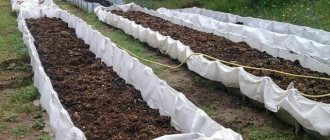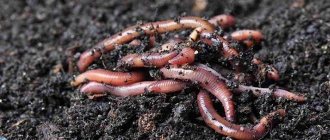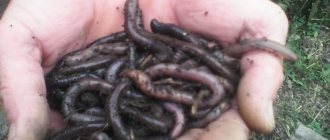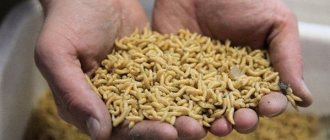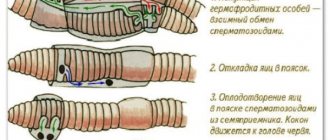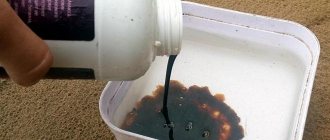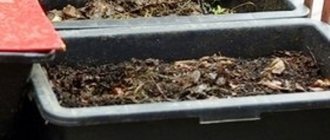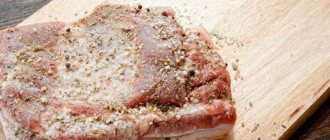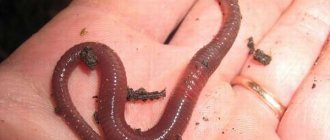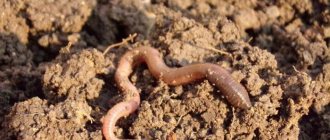Now many people are interested in whether it is difficult to grow and breed Californian worms in ordinary home conditions.
No, it's not difficult! The red worm or Californian is as unpretentious in maintenance as an ordinary worm!
In order to start a business in breeding the Californian worm, you do not need any large financial investments. The worm business generally has many positive aspects, and probably the main one can be called the fact that almost anyone can start doing it, and also the fact that you don’t have to wait long for a return on investment and receiving your first profit.
Business plan for breeding Californian worms
So, if you are a person with little income, but have decided to organize your own business, then we advise you to consider breeding the California worm as an option. This business is quite simple, no special knowledge or skills are required, but there is a demand for worms and this niche in the market is not occupied. The technology for breeding these worms, which were bred in the USA, is quite simple. They are in demand among fishermen (fish bite very well on Californians), but large volumes of worms are in demand among those who raise poultry and fish. Worms are also used to produce high-quality fertilizers that are in demand by vegetable growers.
While noting the ease of opening this business, it is necessary to note the minimal labor costs and insufficient market saturation with products. Those. low competition.
Breeding the Californian worm, with a serious approach and the organization of good conditions for them, as well as with established sales in a short time, will first bring your business to full payback, and then will bring a good profit.
You shouldn’t start with large volumes and think about how to rent a large room. You need to start with an ordinary barn or basement, and later you can think about expanding your production capabilities. Organizing a verifarm will require investments, but in order for them not to be wasted, you must fully master and learn all the nuances of this business.
Answering the most common question: how to breed Californian worm? We will try to figure out what a novice entrepreneur needs to organize a profitable business.
Red Californian
Earthworms for gardening
You could “plant” Eisenia fetida in your garden and inevitably run a wheelbarrow over the worms and their cocoons every time you apply vermicompost, but this is not the best type of worm to fill the soil with. Earthworms are better suited to the conditions that exist outside the vermicompost pile.
There are hundreds of species of earthworms. Some burrow deeply (up to 2 meters), burying organic matter for food in their burrows. Burrows improve soil aeration, and “deep” organic matter improves the quality of its structure. The coprolites of all worms, without exception, are full of useful fertilizers and microorganisms. These creatures secrete mucus from their skin, which also increases productivity.
You can easily “seed” families of worms into the soil, each consisting of a balanced population of adults, juveniles, and cocoons. Give your worms a good home, encourage them to live longer by keeping the soil moist but not waterlogged, and avoid using mineral fertilizers or pesticides. Like plants, worms prefer a neutral to slightly acidic pH environment, low in metal salts and high in organic matter such as mulch, compost and green manure.
Where is the best place to breed?
The big advantage of breeding worms is that there is no need for large areas. It’s very good if you have a summer house or a private house with a cellar; a basement in an ordinary multi-story building may also be suitable.
A worm farm can be organized not only indoors, but also simply in an open area, under a canopy.
If you have decided on the option of outdoor breeding, you must take into account that your business will be seasonal, since with the onset of cold weather the worms will first slow down their activity and then simply die. Therefore, it would be more preferable to keep worms in any room where it is possible to maintain above-zero temperatures throughout the year.
You can practice a combined option, i.e. This is when during the warm season the worms will be kept outside, and with the onset of cold weather they will be transferred to a warm room.
When setting up an outdoor worm farm, the first step is to fence off the area where the worms will be raised. Concreting the floors would also be a good idea. If this is not done, then their main natural enemies, i.e., will find out that there are worms in a given place. all kinds of pests or even moles may visit. You need to know that worms are the main food of moles in the natural environment.
Red Californian worm. Cultivation and breeding
08/03/2017 The red Californian earthworm was bred by scientists from the American state of California (where its name comes from) as a result of breeding work back in 1959.
The worm has an elongated segmented body, slightly flattened on the abdominal side and a rich dark red (burgundy) color. An adult can reach nine centimeters in length and up to five millimeters in thickness. The invertebrate, like all representatives of the worm family, is a hermaphrodite. Life expectancy is approximately sixteen years.
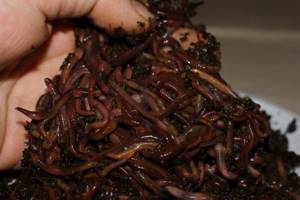
Today, this variety of worms is bred in private farms, in summer cottages and orchards in order to obtain first-class “ Vermicompost”
", which is considered one of the best biologically active and environmentally friendly natural organic fertilizers.
“ Vermicompost
” is formed as a result of processing organic plant residues, and it is this work that Californian worms successfully do, grinding and fertilizing the soil.
Invertebrates are also excellent nutritious food for poultry and are widely used in recreational fishing as highly effective fish bait.

Acquisition
To obtain high-quality “ vermicompost”
“It is necessary to purchase Californian earthworms. This can be done in specialized farms. You should not buy worms from your own hands, because you will not receive guarantees that they were not dug up a kilometer from your home. At a minimum, an enterprise or farm that trades in California worms must have a special permit issued by the services that control their activities.
It is advisable to purchase worms in large quantities at once (at least one and a half thousand individuals), because only this size of the colony will have genetic stability. When purchasing, you must choose live and lively worms that have a juicy red color, and the initial population must contain both young animals and invertebrate cocoons.
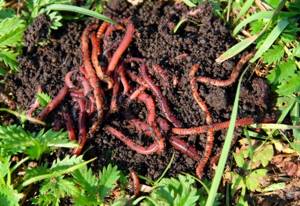
During the course of a day, one adult individual is capable of processing an amount of organic matter that is equal to its own weight.
In a favorable environment, a colony of the Californian worm can increase more than five hundred (!) times within a year. Even in natural conditions, the density of worms can range from one hundred to twenty thousand (!) individuals per square meter of soil.
Preparation of nutrient substrate
The optimal nutrient medium for growing California worms is compost (a heap or pit), which is preliminarily filled with rotted manure (if fresh is added, the worms will die), chicken droppings, grass clippings, food waste (potato peelings, peels of fruits, vegetables and root crops, tops ) and carrion.
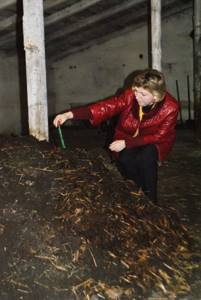
It is advisable to grind large waste fractions or grind them in a meat grinder, since worms do not have teeth and therefore are not able to chew food.
You should not put citrus waste into compost, as it can increase the acidity of the substrate, and worms will not survive in an acidic and fermented environment. For this reason, it is advisable to add crushed eggshells and fine river sand to the compost, the grains of which help invertebrates digest food better.
It must be remembered that worms feed exclusively on rotted plant debris, so it is better not to put the remains of animal food in the compost.
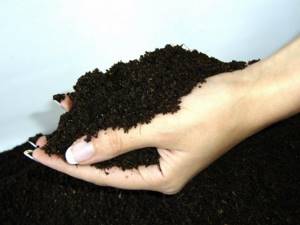
Excellent food for invertebrates are waste fermented milk products, spoiled baked goods, used tea leaves and coffee grounds.
It is advisable to carefully turn the compost from time to time (so as not to harm the growing population), to ensure access of oxygen inside the substrate.
The quality of the finished compost can be checked in the following way: several adult worms are placed on the damp surface of the substrate and then observed. If the subjects do not crawl inside, but remain on top for a long time, it means that the environment is not suitable for their existence and additional composting is required.
To avoid an unpleasant odor and prevent the appearance of all kinds of insects, in particular flies and fruit flies, it is better to build a compost pit away from residential buildings, somewhere in the shade of trees.
During the winter, the compost pit with worms must be covered with durable plastic film.
Breeding worms
To breed California worms you will need two containers (larger and smaller). A smaller container should have a perforated bottom to allow excess moisture to drain through the holes, as these invertebrates react very poorly to excess moisture.
The prepared substrate is placed in a smaller container and the worms are introduced into it, after which it is placed in a larger container that acts as a tray. It is advisable to cover the top of the worms with a thick cloth.
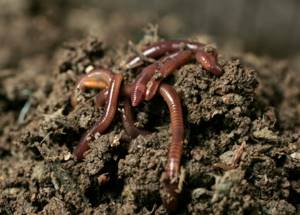
The humidity of the substrate must be at least thirty-five percent. To moisten it, it is advisable to take water not from the tap, since the chlorine content in it can be destructive for the worms, but use either rainwater or let it sit for some time.
By the way, the water that will pass through the substrate layer and accumulate in the second container is an excellent valuable fertilizer, since it washes out “Veriohumus” from the first container. This water is popularly called “vermicha” and is useful for watering indoor flowers and seedlings.
It is advisable to feed invertebrates only after they have eaten the previous portion of food, so as not to provoke the fermentation process.
The optimal temperature for the life of the colony should be about twenty-five degrees plus. As the temperature drops, the worms will feed and reproduce less well, and at five degrees Celsius they may even die.
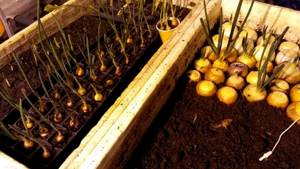
It is noteworthy that, unlike their ordinary counterparts, California worms do not crawl to the surface during rain, preferring to remain in the substrate.
Useful properties of "Veriohumus"
Ready-made " Vermicompost"
“It has no odor and smells like ordinary soil, although it exceeds ordinary humus in humus content by eight (!) times, so its application perfectly heals and fertilizes the soil.
«Vermicompost
"contains a huge variety of enzymes, growth hormones and biologically active substances. It is impossible to “overdo it” and “overdo it” with applying this fertilizer to the soil!
The table below demonstrates only some of the beneficial microelements contained in Vermicompost:
| Humus content | Up to 35 percent |
| Nitrogen content | Up to 2 percent |
| Phosphorus content | Up to 2 percent |
| Potassium content | Up to 1.2 percent |
| Magnesium content | Up to 0.5 percent |
| Calcium content | Up to 3 percent |
«Vermicompost
", as a rule, is applied to the soil in the spring, pouring it into previously prepared holes or rows intended for sowing seeds of cultivated plants, and is also added to the soil for growing indoor and ornamental plants.

Water infusions of " Vermicompost"
» used for pre-soaking seeds, which significantly improves their germination, or used for watering seedlings and feeding flowers.
What is the best way to grow
Next, you need to think about where your American wards will live. You can put together wooden boxes or plastic containers of various sizes, but it is advisable that their height be within forty centimeters. At first, many novice farmers use plastic barrels (preferably large in volume), cut them up and fill them with soil. We have already written in more detail about what containers can be used for breeding worms in the article: Domestic worms - maintenance, feeding, breeding and care

Breeding in boxes
Soil preparation
After preparing the worm houses, you need to fill them with suitable soil. There is nothing complicated here; they live in the same soil as ordinary ones. There is soil with worms on the bottom. If you are just going to buy worms, then you should take into account that in order to make it easier for them to adapt to new conditions, they need to be taken along with the soil in which they were grown. In this case, there is a guarantee that all individuals will survive.
Food is placed on top of the soil layer; humus, kitchen waste, rotted manure and leaves are suitable. If everything is done correctly, then your worms will quickly adapt and quickly begin to grow and produce offspring.
Be sure to pay attention to the fact that there are no metal compounds in the soil, because... this will negatively affect the health of the worms.
After moving in, make sure not only that the worms have food, but also that the temperature is maintained at an acceptable level for them and that there are no large changes.
Red Californian worms are valued due to their rapid growth and high rate of conversion of soil into humus.
Video “California worm breeding at home”
Benefits of California Worms
California red worms have many properties that make them ideal for compost. Of all the worms available for cultivation, the red worm is the most adaptable. They can withstand a wide range of environmental conditions and changes that kill most other breeds.
Unlike regular earthworms, which burrow deep into the soil, California red worms thrive in the top layers of soil directly below decaying plant organic matter. Decaying leaves, grass, wood and manure are all the best food for these worms.
The California worm's voracious appetite makes it a champion of composting. Red worms are quite small, usually no more than 15 centimeters. But don't underestimate them. It is estimated that red worms eat almost 3 times their weight each week.
California worms like to live in colonies, often gathering in a writhing mass around a food source. Maintaining this close contact makes them prolific and an ideal breed to raise on your worm farm. A worm bin measuring 60 x 40 x 40 centimeters can hold over 1,000 red worms. However, for those interested in breeding worms for fishing, it is useful to remember that the prolific red worms will remain quite skinny and short compared to the dendrobena worm. When given more space, these worms develop into excellent fishing worms.
Where can I buy
When starting a business, you may encounter a problem - where to buy worms for breeding. It is better to buy from farmers with a good reputation, because... individuals purchased for breeding must be healthy. As a rule, to start breeding worms, they buy them from worm farms. When purchasing Californians, look for them to be bright red in color and active.
In practice, it has been determined that the initial population should be about 1.5 thousand individuals. To populate a cubic meter of soil you will need a maximum of three families. At wholesale, one worm costs about three rubles (due to inflation, the price may be different).

Private verifarm
Business stages
As you can see, the Californian red worm as a business is quite interesting, because... it is easy to breed. To summarize, we note the main stages of organizing a business:
- choosing a place or room;
- arrangement and preparation of the site;
- preparing containers for breeding;
- soil preparation and filling;
- acquisition of livestock;
- stocking of livestock;
- feeding;
- worm growth;
- reproduction.
After you go through all these stages, you are left with the most enjoyable part, namely harvesting, which will consist of collecting vermicompost, vermicelli and the worms themselves for sale.
Many fishermen know that the Californian worm is well suited for fishing and almost all the fish in our reservoirs bite on it.
When breeding, it is important to maintain a positive temperature in the range from 15 to 25C. Although this species can withstand a significant decrease in temperature, in this case their productivity is noticeably reduced.
Monitor the acidity of the soil, which should be at pH 7, humidity about 78 percent.
Let us note some points that must be taken into account:
- the boxes must be covered with something, the best option is a lid, but a cardboard sheet, hay or burlap will also work;
- the soil must be loosened at least once every three days to ensure access of oxygen to the lower layers of the soil;
- if there is a sharp drop in temperature, then you need to put more manure, straw may also be suitable (the height of the insulation is up to a meter);
- If you find that the worms are acting sluggish or have begun to hide from the light, this may mean that they need to be moved to new soil.
Red worms
Red worms, like other varieties of worms, cannot feed on living plants, but only process their rotten remains. Manure, straw, food and household waste, and fallen leaves are excellent for feeding them.
This worm is distinguished by its fertility and at home, with proper feeding, you can get an offspring 100 times higher than that of other species. For a season per 1 sq.m. area, up to 30 kg of product is collected.
By processing waste, worms turn them into vermicompost - an excellent fertilizer. How to breed worms at home?
Feed
Many new farmers may not know what to feed California worms. In this case, we hasten to calm them down, since they eat food that can be obtained for next to nothing or for very little money.
- Table scraps will do;
- tea leaves;
- wet paper;
- cow or pig manure (it is unacceptable to use fresh or old manure, preferably one that has lain for six months to two years). Rabbit or goat litter can be given straight away.
The soil with worms needs to be watered regularly using a watering can. Drying and excess moisture are unacceptable.
The frequency of feeding depends on the size of the livestock, the season and directly on the feed itself. Typically, the substrate needs to be updated once every one to two weeks.
Breeding worms at home
It doesn’t take much effort to breed red worms, since they are not picky creatures.
So, what is needed first:
- House for small residents. It must be selected in such a way that the worms do not crawl out; a plastic basin or a wooden box measuring 600x500x400 mm will do. Make small holes in the bottom for air passage, about 5 mm. The box is placed on a tray with sand, where excess moisture will be absorbed.
- The soil consists of two parts: the bottom layer 5 cm thick is straw or sawdust, the top layer 10 cm thick is vermicompost, a special soil that is sold in stores.
- The food is laid out in a third layer, 5 cm thick . All kinds of food waste (except potato peelings) are used as feed. This can be fruit and vegetable scraps, porridge, tea or coffee brewing is perfect. It is advisable to grind large particles in a meat grinder. All waste is sprinkled with vermicompost 2 cm thick on top.
It is very important to comply with all conditions of detention. Let's look at them in detail.
Compliance with containment conditions
In order for worms to live and reproduce, all conditions for their maintenance must be met, namely:
- Moderately moist soil.
- It is very important to follow a feeding schedule, preferably once a week. If the soil surface has become smooth and the waste has turned into dark-colored humus, this indicates that your pets are already waiting for the next portion.
- The worm house can be stored in a dark place, away from direct sunlight, by covering it with a piece of damp cardboard.
- It is better to keep each type of worm separately.
- Resettlement every two months. Since the population is growing very quickly, you need to be prepared to use worms as bait, or to spread them. To do this, remove the top layer of soil and divide it into several parts. Place each part in a separate box.
- You need to mix the soil every two days.
Habitat conditions for red worms
The ideal conditions for keeping worms, in which they feel comfortable and reproduce, are:
- The acidity of the soil should be pH=7, the presence of salts should not exceed 0.5%.
- The optimal temperature is from 17 to 24 degrees; if the temperature is lower, the worms do not eat and hibernate.
- Moderate soil humidity is 70-80%; under no circumstances should it be too dry, but not excessively wet.
This is a very important component in keeping worms. Watering is needed abundantly, excess water will be absorbed into the sand, and if the soil dries out, the worms will die. The soil is checked in this way: if, by squeezing part of the soil in a fist, water comes out, then watering is not necessary. Water for irrigation should be left standing for 4 days and at room temperature.
Reproduction of red worms
These creatures are very prolific; in a week you can collect about 1 kg of bait from 30 liters of soil. In 3 months, an adult lays about 24 cocoons containing up to 21 eggs.
After two weeks, the cubs hatch from the eggs, which themselves bear offspring after the same period of time. Worms live 10-15 years and actively reproduce throughout their lives.
Feeding the worms
The growth and reproduction of worms depends on how high-quality and nutritious the food is. The feed should not be very dry so as not to dry out the soil. For better reproduction, dairy products are suitable.
Menu:
- Vegetables and their peelings (beets, carrots, onions, etc.).
- Fruit peelings.
- Tea or coffee brewing.
- Various food waste.
- Porridge.
- Dry bran. For 10 kg of soil you need about three handfuls of rolled oats per week.
- Raw or cooked oatmeal. For 30 liters of soil, 6 handfuls of cereal.
Must be excluded from the menu:
- Egg shells, it reduces acidity.
- You cannot water the soil with chlorinated water, only settled water.
- Potato peelings.
- Oranges and tangerines.
It is very important to knead or grind the food well. You also need to mix the soil and avoid large balls of worms; some individuals die from overheating.
Sales
Selling California worms in bulk is not only much easier, but can also bring a much more tangible profit to the farmer than selling them individually. Therefore, look for those buyers who are ready to constantly and in good quantities purchase your company’s products.
But you shouldn’t neglect the following category of potential buyers:
- summer residents and fishermen;
- farmers;
- zoological stores;
- shops for fishermen;
- farms specializing in fish breeding.
Since the price of the California worm is affordable for many, it is likely that regular wholesale supplies will be concluded, and this is exactly what you need to develop your business.
Advertise the products of your verifarm, and the exotic and loud name of this worm - Californian - can play an important role here. Many will be interested in purchasing it just because of this, and then the buyers themselves will call you, since the qualities of this worm are quite high.
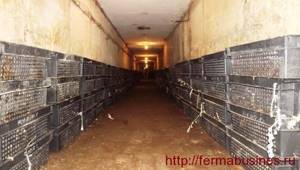
Large veriferma
Red compost worm
Red worms of the species Eisenia fetida are best suited for composting. They are different from Nightcrawlers, which have a habit of burrowing very deeply, making them not suitable for small box breeding. Other species are also sometimes called red worms, but they are not as well suited for commercial farming or vermicomposting.
Earthworms live in decaying organic matter on the soil surface and do not form permanent burrows like other worms. They eat dead organic matter (but not living plants or roots!) and soil microorganisms, digesting them into coprolites that are full of beneficial microorganisms, nutrients, chitin, and plant growth hormones. They can digest up to half their body weight per day. Redworms prefer a dark, moist, pesticide-free environment. Although they can survive in soil or pits at temperatures ranging from 0 to 35°C, they are happiest and most active between 21 and 23°C.
It's easy to start vermicultivating! Find out how to do this in our video and read “How to breed worms.”
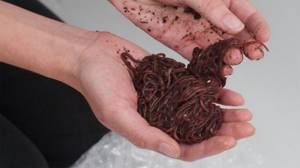
Advertising methods
As you know, advertising is the engine of trade, and here you will need to take certain steps in order to sell already grown Californian worms.
First of all, you should look for those who place advertisements for the purchase of worms. It is quite possible that you will find a completely acceptable option for you in this way. But you shouldn’t stop there, you need to post advertisements - I will sell the Californian worm from America, wherever possible using:
- Internet;
- the press;
- Post advertisements wherever possible, on fences, walls, in the subway and even on trains.
Do not expect that buyers will immediately come running to you (although this is not excluded), advertise constantly and it is quite possible that in just a couple of months you will gather a sufficient and profitable clientele.
Profitability
Having decided where to buy Californian worms for breeding and having arranged a place to keep them, you will soon begin to make your first profit.
- To purchase breeding stock you will need no more than $200.
- Next, there are small expenses for purchasing containers or the material from which you will make it.
- It is also worth considering the costs of heating and lighting the room in which your verifarm will be located.
- Feed costs are minimal, but they also need to be taken into account.
How to populate worms
We recommend reading our other articles
- Why don't violets bloom?
- Strawberry variety Asia
- How to deal with oidium on grapes?
- Why you shouldn't throw away the water after boiling eggs
A minimum of 50 California worms are populated per square meter of substrate. You can populate already adult individuals, but usually cocoons are taken. Having matured, every week one California red worm lays up to 4 cocoons from which 2-20 young hatch. That is, 1,500 young worms are obtained from an individual per year.
You can populate the worm house in any warm period of the year. Initially, they usually plant a handful (up to 20 pieces) to check whether the soil is suitable for them or not. If after a couple of days 5 of them die, then the substrate is too acidic or, on the contrary, alkaline. After finding out the reasons, the acidity is adjusted and the worms are reintroduced.
How to start
Start with small volumes and try to expand your business; your first buyers may be fishermen you know. Sell them at a price lower than in the store and they will be willing to take it from you. Subsequently, as volumes increase, look for wholesale buyers.
It is not easy to determine exactly what kind of income this business can generate because... much depends on the conditions you organize and the availability of feed. You must calculate this moment yourself. It is not difficult.
Good luck!
